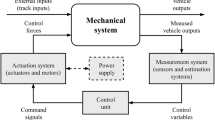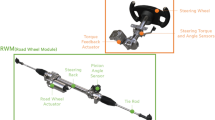Abstract
This paper investigates integrated vehicle dynamics control through coordinating active aerodynamics control, active rear steering, torque vectoring and hydraulically interconnected suspension for improving the overall vehicle performance including handling, stability, and comfort. After developing each chassis control system, it is tested by various manoeuvres in order to assess each subsystem. Then, a rule-based coordinate system is proposed for integrated control of the four chassis control systems. Simulation investigation is performed to display the effectiveness of the proposed integrated vehicle dynamics system. Results demonstrate that the proposed control scheme is able to enhance the multiple performance indices of the vehicle including both the ride comfort, and the lateral stability, compared to the non-integrated control system.
Similar content being viewed by others
References
Abbott, I. H. and Von Doenhoff, A. E. (1959). Theory of Wing Sections: Including a Summary of Airfoil Data. Dover Publications. Mineola, New York, USA.
Ahangarnejad, A. H. (2018). Integrated Control of Active Vehicle Chassis Control Systems. Ph. D. Dissertation. Politecnico di Milano. Milan, Italy.
Ahangarnejad, A. H. and Başlamışlı, S. Ç. (2016). Adaptyre: DEKF filtering for vehicle state estimation based on tyre parameter adaptation. Int. J. Vehicle Design 71, 1/2/3/4, 52–74.
Ahangarnejad, A. H. and Melzi, S. (2019). Active longitudinal load transfer control for improving vehicle’s stability. Int. J. Vehicle Performance 5, 1, 2–17.
Ahangarnejad, A. H. and Melzi, S. (2018). Numerical analysis of the influence of an actively controlled spoiler on the handling of a sports car. J. Vibration and Control 24, 22, 5437–5448.
Ahangarnejad, A. H., Melzi, S. and Ahmadian, M. (2018). Numerical comparison of two methods for integration of active rear steering, torque vectoring and hydraulically interconnected suspension. Int. J. Vehicle Systems Modelling and Testing 13, 2, 125–148.
Cairano, S. D. and Tseng, H. E. (2010). Driver-assist steering by active front steering and differential braking: Design, implementation and experimental evaluation of a switched model predictive control approach. Proc. 49th IEEE Conf. Decision and Control (CDC), Atlanta, Georgia, USA.
Chen, Y., Ahmadian, M. and Peterson, A. (2015). Pneumatically balanced heavy truck air suspensions for improved roll stability. SAE Paper No. 2015-01-2749.
Doumiati, M., Sename, O., Dugard, L., Martinez-Molina, J.-J., Gaspar, P. and Szabo, Z. (2013). Integrated vehicle dynamics control via coordination of active front steering and rear braking. European J. Control 19, 2, 121–143.
Emirler, M. T., Uygan, İ. M. C., Gelbal, Ş. Y., Gözü, M., Böke, T. A., Güvenç, B. A. and Güvenç, L. (2016). Vehicle dynamics modelling and validation for hardware-in-the-loop testing of electronic stability control. Int. J. Vehicle Design 71, 1–4, 191–211.
Falcone, P., Tufo, M., Borrelli, F., Asgari, J. and Tseng, H. E. (2007). A linear time varying model predictive control approach to the integrated vehicle dynamics control problem in autonomous systems. Proc. 46th IEEE Conf. Decision and Control, New Orleans, Louisiana, USA.
Fredriksson, J., Andreasson, J. and Laine, L. (2004). Wheel force distribution for improved handling in a hybrid electric vehicle using nonlinear control. Proc. 43rd IEEE Conf. Decision and Control (CDC), Nassau, Bahamas.
Guvenc, B. A., Acarman, T. and Guvenc, L. (2003). Coordination of steering and individual wheel braking actuated vehicle yaw stability control. Proc. IEEE Intelligent Vehicles Symp., Columbus, Ohio, USA.
Han, K., Choi, M., Lee, B. and Choi, S. B. (2018). Development of a traction control system using a special type of sliding mode controller for hybrid 4WD vehicles. IEEE Trans. Vehicular Technology 67, 1, 264–274.
Jalali, K., Uchida, T., Lambert, S. and McPhee, J. (2013). Development of an advanced torque vectoring control system for an electric vehicle with in-wheel motors using soft computing techniques. SAE Paper No. 2013-01-0698.
Le, A.-T. and Chen, C.-K. (2016). Vehicle stability control by using an adaptive sliding-mode algorithm. Int. J. Vehicle Design 72, 2, 107–131.
Mousavi, A., Davaie-Markazi, A. H. and Masoudi, S. (2017). Comparison of adaptive fuzzy sliding-mode pulse width modulation control with common model-based nonlinear controllers for slip control in antilock braking systems. J. Dynamic Systems, Measurement, and Control 140, 1, 11014–1–11014–15.
Ogata, K. (1997). Modern Control Engineering. 3rd edn. Prentice Hall. Upper Saddle River, New Jersey, USA.
Pacejka, H. B. (2012). Tyre and Vehicle Dynamics. Butterworth-Heinemann. Oxford, UK.
Plumlee, J. H., Bevly, D. M. and Hodel, A. S. (2004). Control of a ground vehicle using quadratic programming based control allocation techniques. Proc. IEEE American Control Conf., Boston, Massachusetts, USA.
Tabti, K., Bourahla, M. and Mostefai, L. (2013). Hybrid control of electric vehicle lateral dynamics stabilization. J. Electrical Engineering 64, 1, 50–54.
Tjonnas, J. and Johansen, T. A. (2010). Stabilization of automotive vehicles using active steering and adaptive brake control allocation. IEEE Trans. Control Systems Technology 18, 3, 545–558.
Vignati, M., Sabbioni, E. and Tarsitano, D. (2016). Torque vectoring control for IWM vehicles. Int. J. Vehicle Performance 2, 3, 302–324.
Wu, J., Wang, Q., Wei, X. and Tang, H. (2010). Studies on improving vehicle handling and lane keeping performance of closed-loop driver-vehicle system with integrated chassis control. Mathematics and Computers in Simulation 80, 12, 2297–2308.
Yu, S.-H. and Moskwa, J. J. (1994). A global approach to vehicle control: Coordination of four wheel steering and wheel torques. J. Dynamic Systems, Measurement, and Control 116, 4, 659–667.
Zhang, H. and Wang, J. (2017). Active steering actuator fault detection for an automatically-steered electric ground vehicle. IEEE Trans. Vehicular Technology 66, 5, 3685–3702.
Author information
Authors and Affiliations
Corresponding author
Rights and permissions
About this article
Cite this article
Ahangarnejad, A.H., Melzi, S. & Ahmadian, M. Integrated Vehicle Dynamics System through Coordinating Active Aerodynamics Control, Active Rear Steering, Torque Vectoring and Hydraulically Interconnected Suspension. Int.J Automot. Technol. 20, 903–915 (2019). https://doi.org/10.1007/s12239-019-0084-x
Received:
Revised:
Accepted:
Published:
Issue Date:
DOI: https://doi.org/10.1007/s12239-019-0084-x




